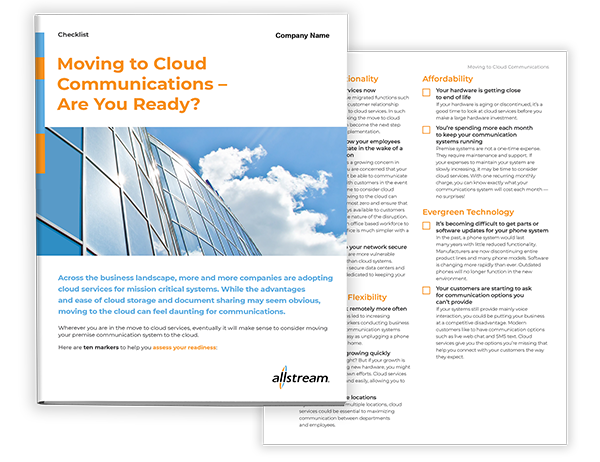Workplaces of the Future
The modern workspace has experienced rapid change over the last several years. With trends toward remote work and flexible workspaces continuing to accelerate, companies now have new opportunities to reimagine the workspace.
In this business environment, work is no longer just a separate physical space where one goes every day. Rather, “work” is something we do from a variety of locations. It means communicating and collaborating across geographies, and it requires more robust connectivity than ever. The modern workspace includes everything from an urban high rise to a home office to a flexible workspace to a dining room table. Work isn’t the place, but the action.
Transforming your office to adapt to the needs of the modern team isn’t impossible. With the right approach, you can create a work environment where your team can connect, communicate and collaborate from anywhere, at any time, on any device.
According to an Upwork survey from October 2020, 56.8% of teams work remotely at least part of the time.

Reimagine the Workspace
The boundaries between work, home and leisure are blurrier than ever, and people are just as likely to work at the dining room table as they are to work in an office building. In fact, an Upwork study conducted in late 2020 found that approximately 36.2 Americans will be working remotely by 2025—an 87% increase from pre-pandemic levels.
This flexible work environment comes with challenges, however—especially for the IT department. Companies need to find ways to support full-time remote workers, full-time office workers, and everyone in between. Now is a great time to reimagine a space that can meet the needs of your employees and customers well into the future.
Over the next several years, the company workspace will likely shift in a number of ways. Here are just a few changes on the horizon:
- Improved collaboration and remote work technology: From improving connectivity options for remote workers to adopting cloud and collaboration apps, it’s vital that companies equip their teams to work from anywhere on any device.
- Shared desks or spaces and hybrid work arrangements: An increasingly common approach, shared spaces allow employees to plan time in a workspace as needed. Team members can come into the office for face-to-face connection or to have a quiet space to finish projects and work remotely when they aren’t needed in the office.
- More comfortable, “homey” spaces: With so many employees now comfortable working at home, companies will want to give them some of the same amenities in the office. Comfortable furniture and more residential color schemes help mimic the feel of the home office.
- More space per employee: With new concerns over hygiene, many companies are increasing their estimate of square footage per employee from 125 sq ft per person to a more generous 195 sq ft per person. This extra space, combined with hybrid and flexible schedules, can allow employees to maintain physical distance while in the office.
- Increased sanitation measures: Frequent sanitization of surfaces, improved air filtration and screening measures for employees entering the office space are just a few of the measures companies are considering to keep employees healthy.
- Increased self-serve options: Some companies are already using vending machines to dispense personal safety equipment. Kitchens and breakrooms will likely employ more self-serve options for food and drink as well.
It’s impossible to talk about corporate real estate in a post-pandemic world without addressing the importance of keeping employees and customers healthy and safe. Going forward, companies will need to address issues such as sanitation, air filtration and health screening of employees and visitors and ensure they have the connectivity to support these new imperatives along with a dispersed workforce.
In this new world, technology is a vital link in creating a workspace that meets high health and safety standards.
- Connectivity: Robust connectivity across all locations allows employees to quickly pivot to working remotely when the company workspace isn’t an option. For example, if an employee falls ill and exposes co-workers, those affected can easily work from home if they have the right connectivity.
- Network monitoring: With team members spread across geographies, it’s more important than ever to give the IT department ways to oversee the network. Solutions such as SD-WAN give better security and control over a dispersed network while simultaneously positioning team members for better productivity.
- Integrations: As companies implement more touchless technology to support remote working, communication and collaboration, healthy building initiatives and more, integrations become a business imperative. The right integrations of apps and monitoring software can help companies have complete line of sight into their IT systems from a centralized location.
Collaboration apps, cloud technology and robust connectivity can allow your employees to work anywhere, anytime, on any device. For companies that embrace and adopt a fully collaborative approach to work, there are no limits to where and when employees can be productive.
According to IDC, the worldwide unified communications and collaboration market grew 26.7% in 2020.
Many companies realized just how unprepared they were for business disruption in spring of 2020 when government restrictions required them to close their offices and ask employees to work from home. But disruption doesn’t just come in the form of global pandemics. Anything from a localized weather event to a national emergency can keep employees from getting to the office.
Reimagining the workspace and retooling work technology can position your company to weather disruption. For more information about how to maintain business continuity, download our sheet Five Steps You Can Take Today to Prepare for the Next Disruption.
Now is the perfect time to look forward and think about how to create a work environment that encourages collaboration, positions your company for growth, meets the needs of customers and sets a good example for other organizations.
- Business continuity: Don’t be caught unprepared for the next disruption. Now is the time to make sure your employees can collaborate from anywhere. It’s a good time to think about migrating to cloud solutions that position your team to work anywhere on any device.
- Connectivity: Whether your team works from one location or hundreds, connectivity is mission-critical for everything from day-to-day operations to surviving disruption to long-term competitive advantage. Commercial landlords need to ensure that buildings have the infrastructure necessary for tenants, and business owners will need to look for properties and locations that provide the best foundation to build their own networks. Increasingly, companies will look for real estate that indicates a sustainable and forward-thinking approach to connectivity through certifications such as Wired Score.
- Devices for the mobile worker: As work arrangements become more fluid, it may be a good time to make sure that your team members are equipped with everything they need to shift from office to home and back again as needed.

Wherever you are in transforming your office for hybrid work, eventually it will make sense to consider moving your premise communication system to the cloud.
Here are ten markers to help you assess your readiness.
Workspace options
With all of the options available for the modern office—from more traditional in-office or on-premises configurations to fully remote and cloud configurations—how can leaders and decision makers find the best options for their unique situations?
To find solutions that work for your company, start with the following roadmap:
- Assess your technology: Do your team members need more devices? What cloud apps are you using, and do those work for everyone? Do you need better connectivity? Better network monitoring tools?
- Look for gaps: Survey your employees to find the gaps in your technology tools. For example, if team members are struggling with connectivity, can you provide more robust options? If cloud apps are cumbersome or inefficient, are there better ones on the market?
- Assess your current office space: Do you have the connectivity you need to support your entire workforce, both in and out of the office? Do you need more desks? Fewer desks with more space between? Does your landlord support your reimagined workspace with features such as improved custodial service, high quality air filtration and robust technical infrastructure to support a dispersed workforce?
- Survey your employees: Ask your employees for input on where and when they want to work. If it’s important that you have employees present in your office space at all times, ask your team for scheduling preferences.
- Break down priorities: Reimagining and retooling your office can feel overwhelming. Break it down into priorities and steps and take things one piece at a time as budget and schedule allow.
- Ask for help: From cloud and connectivity to real estate to sustainability, expert advice exists to help you reimagine your office. Whether you look for help online or hire someone to assist, getting the input of an expert can make transforming your office a much smoother experience.
Technology is a foundational piece of any office transformation. Look for an experienced solution provider that can help navigate the process.
Here are a few features to look for:
- Expertise in telecommunications, including cloud, hybrid and on-premises solutions.
- Deep knowledge of network design to ensure your entire team stays connected and secure.
- Emphasis on collaboration tools such as conferencing and shared apps.
- Flexibility and efficiency.
- Ability to bundle services for maximum budget efficiency.
- Hyper-personalized experience with enhanced, easy-to-use self-serve options.
An experienced solution provider will take the time to evaluate your unique needs and situation.
Typically, you’ll be asked to join a personalized “discovery call,” where an expert can answer your questions, assess your needs and propose a customized solution.

Businesses that plan for unexpected disruptions are more likely to survive and thrive afterwards, ready to meet market demands with innovative solutions. Is your organization ready for the future and the unexpected?
Why Allstream?
With Allstream’s wide array of communication and collaboration solutions, you can transform your workspace to a flexible, collaborative model that allows your team to work from anywhere on any device. Allstream’s solutions can help your team maximize productivity and keep you competitive in the market.
With over 170 years of experience, Allstream has deep roots and longstanding history with helping customers maximize productivity wherever they work. Our depth and breadth of experience means that you have the tools you need to allow employees to work from anywhere, on any device, while still providing an excellent customer experience.
Allstream partners with industry-leading providers such as Cisco and Mitel to give our customers the collaboration, communication and connectivity solutions they need. With the help of Allstream experts, you can improve employee satisfaction, meet customer demands, and remain flexible in the face of disruption.
- Flexibility and adaptability: Work and collaborate from anywhere, on any device.
- Budget control: By leveraging all or part of an OpEx model, you can eliminate potential surprises related to legacy or on-premises components.
- Innovation: From smart rooms to AI to touchless technology, we partner with companies that offer the most advanced technology on the market.
Whether you have just a few team members or hundreds of employees, Allstream has experience working with businesses of all sizes. Contact us today to learn how we can help your business.
Success Story | Kimball Equipment
Kimball Equipment stumbled along on inconsistent phone systems across various offices— leading to frequent outages. With UC Cloud Voice, the entire company is now on a unified system with modern collaboration tools at a reduced cost.
Ready to get started? Explore Allstream’s array of remote work solutions.
Call Sales at 1-833-603-6600, or let us know more about your needs and an Allstream expert will be in touch. Our experienced representatives can make a personalized recommendation for you, based on your business’ specific situation and requirements.



